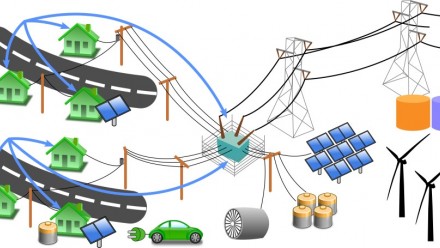Smart grid
In the future, the electricity grid will feature millions of intermittent and distributed generation sources, support many electric vehicles, and give greater incentives and control to consumers to optimise energy usage. It will require an unprecedented level of automation, to self-manage, self- reconfigure and self-heal. This vision challenges the human-controlled, top down management style of traditional grids, which relies on the existence of a few predictable and adjustable fossil fuel generators.
The ECI Smart Grid Cluster conducts research into the use of control, communications, optimisation, artificial intelligence, machine learning, data and analytics to support future energy systems, in areas such as grid integration of renewables and storage, microgrids, energy price and solar forecasting, demand response, and home and building energy management.
Battery Storage and Grid Integration Program
The new Battery Storage and Grid Integration Program, instituted in April 2018, is jointly hosted within the ANU by the Research School of Engineering and the Research School of Chemistry. The program undertakes activities related to the development, integration, operation, and optimisation of energy storage in electricity grids, and electricity markets, globally.
Of particular relevance to the Smart Grid Cluster, the devices, optimisation and control stream is will undertake research and development of distributed optimisation and control capabilities (both hardware and software) to allow the effective and efficient operation of distributed energy resources, including battery and energy storage.
The data and analytics stream will progress the state of the art in modelling, forecasting and prediction that is critical to the effective operation of energy storage capabilities in the electricity system and their participation in energy, ancillary and network services markets.
The Battery Storage and Grid Integration Program is funded by the ACT government and the Australian National University.
Consumer energy systems providing cost-effective grid support (CONSORT)
This ARENA funded project , which commenced in April 2016, has resulted in the successful development and deployment on Bruny Island, Tasmania, of novel algorithms to automatically coordinate consumer-owned PV-battery systems to simultaneously provide network support and consumer value.
Building on expertise in optimisation and scheduling for smart grids within the ANU’s Research School of Computer Science, the deployed system has lead to a reduction of around 30% in the use of backup diesel during holiday usage peaks, and has completely prevented the use of diesel on at least one occasion.
The project has been awarded EESA’s Energy Project of the Year (2018), the Clean Energy Council’s Community Engagement Award (2018), and the Engineers Australia’s Tasmanian Engineering Excellence Award (2018).
This project is a collaboration with Tasmanian Networks, Reposit Power, the University of Sydney and the University of Tasmania.
Demand-side management through community aggregation of distributed energy resources
This research project, based in the Research School of Engineering, is developing community market models for small-scale (e.g. a small residential community) electricity demand-side management, using community energy storage systems and rooftop PV power generation. Electricity demand-side management plays an essential role in maintaining reliable grid operation with the rapid increase of electricity demand.
The project has developed algorithmic solutions to economically operate community energy storage systems with user-owned solar power generation which reduce peak electricity demand while delivering economic benefits to users.
Leaders
Researchers
- Dr Abhishek Bhardwaj
- Professor Lachlan Blackhall
- Associate Professor Kim Blackmore
- Dr Sid Chau
- Dr Dan Gordon
- Dr Shan (Dora) He
- Dr José Iria
- Dr Niraj Lal
- Brenda Martin
- Dr Chathurika Mediwaththe
- Professor Ian Petersen
- Dr Hedda Ransan-Cooper
- Dr Paul Scott
- Associate Professor Marnie Shaw
- Professor Kerry Taylor
- Professor Sylvie Thiebaux
- Dr Michael Thomas
Students
- Ahmad Attarha
- Kevin Chadwick
- Benjamin Hofmann
- Chengzhe (Kevan) Li
- Massie Mahmoodi
- Nanduni Nimalsiri
- Dr Rebbecca Ty Thien
Professional staff
2022
FACTS: a Framework for an Australian Clean Transport Strategy, Featured ANU authors: Bjorn Sturmberg, Andrew Blakers, Liz Hanna.









